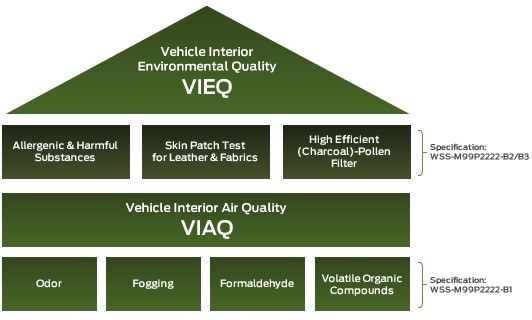Improving Vehicle Interior Environmental Quality and Choosing Allergy-Tested Materials
At Ford, it is our corporate social responsibility to develop and offer products that are safe, sustainable and progressive. As part of this effort, Ford is proactively addressing society’s growing concern about vehicle interior environmental quality, including air quality and allergens. Consistent with our ONE Ford global integration plan, a global cross-functional team at Ford focuses on selecting interior materials to reduce the risk of allergies and volatile organic compounds and works with suppliers to verify that we meet voluntary initiatives through rigorous scientific testing. This team is committed to investigating and developing comprehensive global approaches and strategies to address issues relating to vehicle interior air quality. The team has established global design guidelines for materials and filtration and is migrating those guidelines across Ford’s product lines.
Specifically, this team has been working since 2007 to develop a set of Vehicle Interior Air Quality (VIAQ) specifications that require the consideration of the air-quality and allergen impacts of the materials and components in our vehicles. Under this standard, vehicle engineers test more than 100 materials and components for allergy issues. In addition, all components that have direct and prolonged skin contact – such as the steering wheel and seat covers – are dermatologically tested. The complete VIAQ standards include requirements for fogging and odor at the component level, air filtration, allergy patch testing and total vehicle organic compounds. Many vehicles are also equipped with high-performance pollen filters to prevent allergenic pollens from entering the vehicle. Initially, the requirements were applied to European-based vehicles, and we are now phasing them in in the U.S. We plan to implement them in our South American and Asia Pacific and Africa operations in the future.
We are also implementing a voluntary vehicle interior air-quality and allergen-free third-party certification process. This certification can be used by vehicle engineers in markets where certification is likely to be valued by consumers.
The following graphic shows our overall approach to improving vehicle interior environmental quality, including our allergen and VIAQ specifications.

Ford of Europe vehicles were the first vehicles worldwide to be awarded an “allergy-tested interior” certification by TÜV Rheinland, a Germany-based organization that controls and approves quality standards for industrial and consumer products. To obtain this certification, components in the vehicle interior must meet strict requirements focused on three key areas: measuring and meeting standards for the in-vehicle concentration of volatile organic compounds; minimizing the risk of allergic reactions; and high-efficiency air filtration. The requirements for minimizing the risk of allergic reactions include ensuring that no substances with allergenic potential (e.g., latex, nickel, chromium VI) are used for components likely to have contact with people’s skin. They also require the use of an efficient pollen filter to protect passengers against allergenic particles in the outdoor air.
Nine of Ford’s European models have met these requirements: the new Ford Fiesta, European Focus (including the Focus Coupe-Cabriolet), European Fusion, five-passenger C-MAX, seven-passenger Grand C-MAX, Kuga, S-MAX, Galaxy and Mondeo. In February 2008, the Berlin-based European Center for Allergy Research Foundation awarded Ford with its quality certificate – an additional recognition of the Company’s “allergy-tested interior vehicle” initiative.
Looking ahead, we are researching ways to use in-vehicle communication systems to help drivers monitor and maintain their own health and wellness. We are partnering with Microsoft, Healthrageous and BlueMetal Architects to develop systems that extend health management into the personal vehicle in a nonintrusive fashion. The system would work by using Ford’s hands-free SYNC® communication technology to capture biometric and vehicle data as the basis for real-time health and wellness advice and monitoring. For example, a driver could provide voice inputs, detailing important aspects of his or her health routine – such as the number of glasses of water consumed during the day, or what pills have been taken. Working with partner companies, the data received from the driver could be uploaded into the driver’s approved health data cloud and processed with other health data to create graphical reports the driver can access after having left the vehicle.
